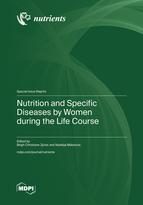Nutrition and Specific Diseases by Women during the Life Course
A special issue of Nutrients (ISSN 2072-6643). This special issue belongs to the section "Nutrition in Women".
Deadline for manuscript submissions: closed (15 January 2023) | Viewed by 35300
Special Issue Editors
Interests: nutrition factors; lifestyle; cardiovascular risk factors; cancer; pregnancy outcomes
Interests: Women healthcare research; health of pregnant women; chronic diseases research; social and life course epidemiology; health lieracy and nutrition
Special Issue Information
Dear Colleagues,
In Western countries, the prevalence of risk factors for premature mortality and early non-communicable diseases grow according to increasing stress, poor nutrition and less physical activity.
The effects of nutrition on the prevention, reduction and avoidance of diseases by women are well-known, but mechanisms are widely unexplored. The link between lifestyle and the growing rates of different diseases (e.g., cervical, ovarian carcinoma, breast cancer, cardiovascular diseases or diabetes mellitus) needs to be investigated further. Nowadays, the discussion grows according to the individuality of the microbiome and its role in health and disease. However, what are the key players in nutrition or physical activity that dominate lifestyle and need to be pointed out in prevention programs? More population-based studies for the association between dietary factors and the occurrence of diseases are needed leading to the central question: How can we prevent multimorbidity and reduced life quality in the elderly?
In this Special Issue on nutrition and women’s health, we welcome submissions on all aspects of the relationship between nutrition, lifestyle factors and outcomes by women during the life course.
This includes original research, systematic reviews and meta-analyses. Methodological studies on dietary factors and measurements to describe the microorganisms and metabolites using new technologies in terms of their application in epidemiological studies are also gladly admitted. We encourage the scientific community to make significant and innovative contributions to enhance our knowledge of the effects of diet on outcomes by women during the course of life.
Prof. Dr. Birgit‐Christiane Zyriax
Dr. Nataliya Makarova
Guest Editors
Manuscript Submission Information
Manuscripts should be submitted online at www.mdpi.com by registering and logging in to this website. Once you are registered, click here to go to the submission form. Manuscripts can be submitted until the deadline. All submissions that pass pre-check are peer-reviewed. Accepted papers will be published continuously in the journal (as soon as accepted) and will be listed together on the special issue website. Research articles, review articles as well as short communications are invited. For planned papers, a title and short abstract (about 100 words) can be sent to the Editorial Office for announcement on this website.
Submitted manuscripts should not have been published previously, nor be under consideration for publication elsewhere (except conference proceedings papers). All manuscripts are thoroughly refereed through a single-blind peer-review process. A guide for authors and other relevant information for submission of manuscripts is available on the Instructions for Authors page. Nutrients is an international peer-reviewed open access semimonthly journal published by MDPI.
Please visit the Instructions for Authors page before submitting a manuscript. The Article Processing Charge (APC) for publication in this open access journal is 2900 CHF (Swiss Francs). Submitted papers should be well formatted and use good English. Authors may use MDPI's English editing service prior to publication or during author revisions.
Keywords
- dietary factors
- nutrition
- women health
- specific diseases
- gynaecologic diseases
- non-communicable diseases
- life course epidemiology
- pregnancy
- menopause
- prevention







